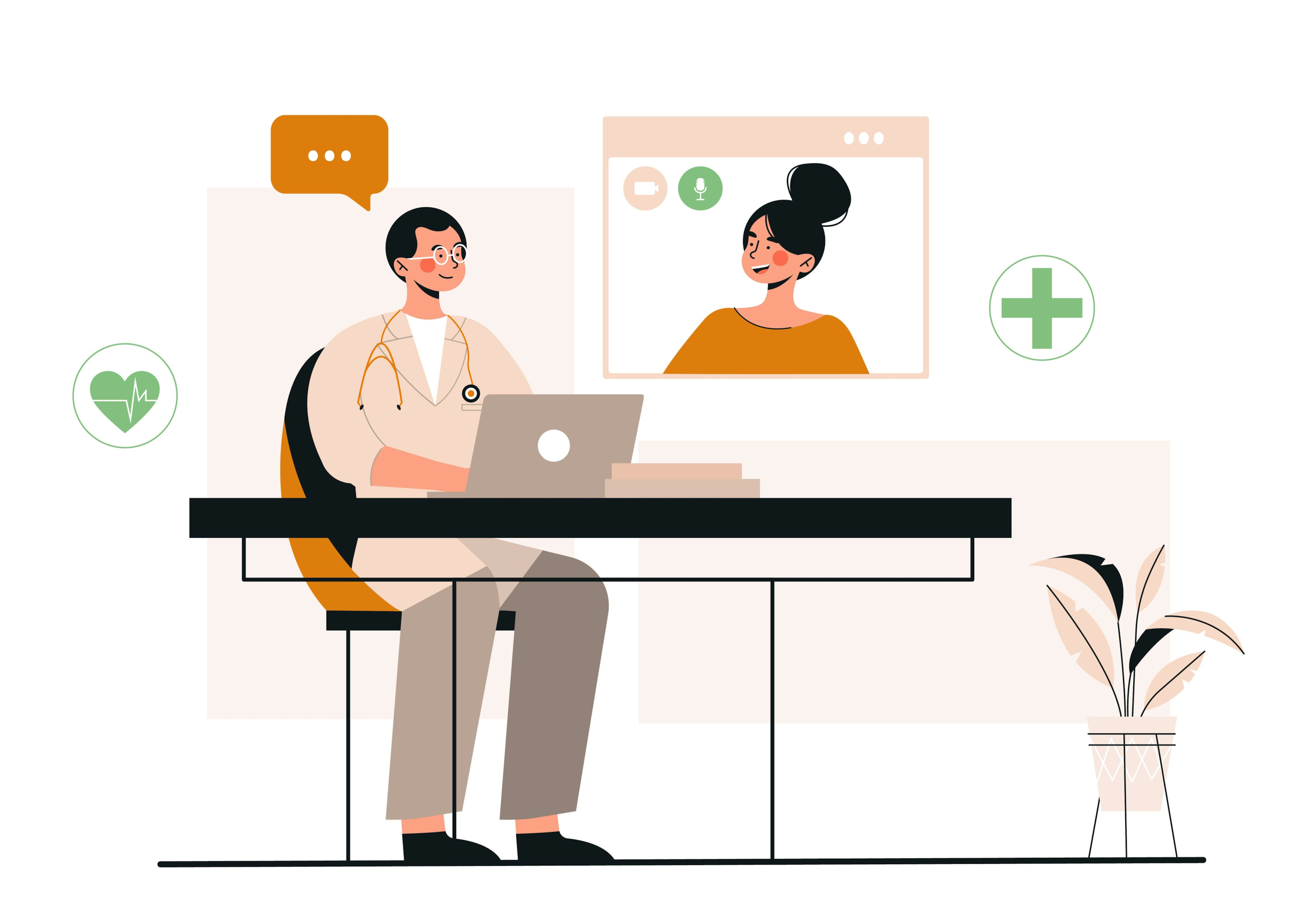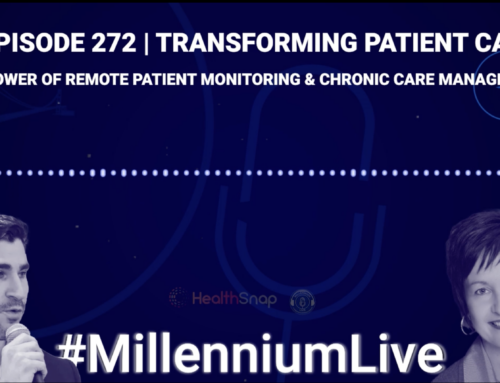Modern healthcare systems face an unprecedented crisis in the 21st century. COVID-19 has taught us that we need to look beyond in-person consultations as the main paradigm for doctor-patient consultations.
The pandemic exposed particularly the elderly and immunocompromised patients to serious health risks. Venturing out to crowded places, particularly hospitals, puts these patients at a high risk of catching potentially deadly infections.
When pandemic lockdowns and social distancing restrictions were imposed, telemedicine services and technologies such as Remote Patient Monitoring (RPM) came into the spotlight. Thanks to the widespread access to cellular connectivity and mobile device, universal adoption of telehealth is actually practical and economical.
In this guide, we will trace the evolution of RPM, and analyze the key predictions and futuristic trends shaping this technology in 2023.
The Rise and Evolution of Remote Patient Monitoring
Remote Patient Monitoring refers to the use of any form of long-distance communication to share patient medical data and records in a healthcare setting. Sharing symptoms and other details via the telephone with a doctor could be considered an early form of remote monitoring.
This practice probably originated sometime in the 1800’s after the invention of the telephone. In the 1920’s, the idea of using radio and television for telemedicine was proposed. Finally, in 1948, x-ray images were sent via telephone across 24 miles to a doctor for the first time in Pennsylvania.
By the 1950’s, telemedicine and Remote Patient Monitoring began to emerge in an elementary form. In the US and Canada, radiologists started sharing scan images via co-axial cable. Closed-circuit TVs were used for remote patient consultations at the Nebraska Psychiatric Institute and Norfolk State Hospital in 1960. The Psychiatric Institute continued to pioneer telemedicine in collaboration with NASA.
In the 1990’s, the rise of the internet gave medical professionals a more advanced way to transmit patient data through personal computers. And in 2010, the first meaningful legislation for the regulation of telehealth was passed – the Affordable Care Act and Meaningful Use regulation.
Modern telemedicine is far ahead of the humble wired connections used by coaxial cables and land telephone lines. The latest devices use wireless cellular connectivity to create an innovative new world of digital Remote Patient Care.
The capabilities of RPM have also evolved much beyond the mere sharing of radiological images. We now have wearable devices and implants capable of monitoring the vitals of patients with chronic health conditions and sharing the same in near-real time with primary care providers.
Remote Patient Monitoring systems are widely used for tracking weight, blood sugar levels, pulse, oxygen saturation, blood pressure, body temperature, and more. They are also useful for tracking mental health issues, pain management, and medication compliance (pill tracker).
In England, the NHS used innovative “virtual wards” to track the heart rate, blood oxygen, and temperature levels of cystic fibrosis patients on an experimental basis. Powered by RPM systems, these “virtual wards” reduce hospital stays and simplified the process of re-admission for patients whose vitals deteriorated.
The latest advances in the field of RPM revolve around the use of cellular technologies. These mobile-enabled Remote Patient Monitoring (mRPM) systems have several advantages over devices that rely on wireless internet (WiFi) networks.
An mRPM system is more economical and user-friendly from a patient’s perspective. It provides standalone communication features and can work anywhere as long as mobile network connectivity is available. The near-instant communications and a patient-friendly mobile app further enhance the ability of mRPM to facilitate quick access to medical care for patients with chronic diseases.
Top RPM Trends and Predictions for 2023 and Beyond
In the aftermath of the peak of the pandemic, in 2023 there is a renewed sense of urgency to adopt Remote Patient Monitoring technologies, and research for more advancements is ongoing at a frenetic pace.
Rapid Growth in the Adoption and Utilization of RPM Devices
The global market for RPM devices is expected to register double-digit growth in 2023 – at an estimated rate of 13.3% CAGR. From a total market value of $1.18 billion in 2022, it’s expected to increase to $1.34 billion in 2023 and $2.14 billion by 2027. Asia-Pacific and North America will continue to be the largest regional markets for Remote Patient Monitoring technologies.
This growth is likely to be fueled by the increasing demand for heart monitors, breath monitors, glucometers, BP monitors, pulse oximeters, spirometers, and other multi-parameter monitoring devices. Leveraging mobile communication technologies, these medical devices are capable of sending patient health data to doctors in near real-time.
A major driver for the rapid expansion in demand for RPM devices is the increasing shortage of skilled healthcare professionals. Due to the impact of the pandemic and other macro-economic factors, there has been considerable attrition in the health industry, with a number of doctors and nurses leaving the sector in pursuit of other opportunities. In many instances, health care workers have experienced burnout.
The problem has been further exacerbated by the increasing healthcare demands of rapidly aging populations in major markets like the US, Europe, and South Korea. As chronic diseases proliferate in these countries, regular and timely patient monitoring is becoming more challenging due to staff shortages and other operational limitations.
In the US in particular, the growing burden on the health system appears to be more severe than many other countries. The Blue of Labor statistics indicate that there will be an additional demand for 203,700 new nurses each year in the nation’s healthcare system by 2026. When we include other healthcare professionals like physicians and lab technicians, the demand will exceed 2.3 million by 2025, according to a report by Mercer.
Against all this, the projected supply of new nurses by 2026 will only be around 430,000, which is certainly not going to be enough. As hospitals scramble to find a balance between caring for the patients and reducing the workload of their staff, the adoption of advanced RPM systems will increase significantly.
This could also potentially contribute to a reduction in operating expenses and an increase in the revenues of hospitals and other healthcare service providers. Remote Patient Monitoring systems that integrate advanced IoT and mobile cellular technology can be used to great in effect in the treatment of cancer patients, diabetes management, cardiovascular health monitoring, sleep disorder management, fitness monitoring, and more.
These devices could be highly beneficial to hospitals, assisted living facilities and hospices, private clinics, and patients in home care settings. Through the use of miniaturized multi-sensing devices, doctors can monitor their patient’s vitals from afar and recommend interventions and treatment changes whenever necessary. With so many advantages, the adoption of RPM devices is expected to accelerate in the US in 2023.
COVID will Continue to Influence the Growth of Remote Delivery of Healthcare Services
Almost 3 full years after the outbreak of the coronavirus, our healthcare systems made massive progress in treating COVID-19, preventing deaths, and reducing the risk of transmission. Despite the widespread deployment of vaccines, the virus continues to wreak havoc in pockets around the country.
The problem is particularly acute in areas that have a historically high load of patients with seasonal flu and respiratory syncytial virus (RSV). Although mask mandates and social distancing are no longer considered necessary in public spaces after the introduction of vaccines, hospitals still cannot afford to take any chances.
High-risk patients with immunological issues still require isolation and an increased focus on preventive care. COVID-19 poses an unprecedented threat to such demographics as the elderly, diabetics, and cancer patients – doctors have realized the need for a renewed focus on continuous monitoring, something that was often neglected in the past.
As we enter a “post-pandemic phase,” we could be looking at impending healthcare challenges in the foreseeable future. Due to disruptions in the prevention and management of chronic diseases (because much of the medical attention was focused on fighting off Covid related illnesses), there is a risk of a potential surge in the number of patients with chronic conditions in the United States. Some studies indicate that a COVID-19 infection itself increases the risk of chronic diabetes and cardiovascular issues.
The beleaguered CDC has issued repeated warnings about the evolution of a healthcare emergency of this type. “COVID-19 has resulted in decreases of many types of health care utilization, ranging from preventive care to chronic disease management and even emergency care,” according to the agency.
The CDC goes on to say: “We have lost ground in prevention across the chronic disease spectrum and in other areas, including pediatric immunization, mental health, and substance abuse.”
As chronic disease monitoring and management becomes a critical priority, RPM technology will assume greater significance in the healthcare industry. It’s a powerful tool capable of boosting our patient monitoring abilities in unprecedented new ways.
And the Federal Government seems to be acknowledging this reality. During the early days of the COVID-19 public health emergency, new provisions for the inclusion of remote care was adopted by the government.
These provisions have not been repealed in the post-lockdown phase – in fact, the 2023 Final Rule seems to have indirectly extended those provisions even after the formal lifting of the public health emergency status. But these provisions may still be repealed later in 2023, as the unwinding of the Medicaid Continuous Enrollment provision gathers steam.
Continued Increase in the Popularity of At-Home Care
The COVID-19 pandemic normalized many new processes, like working from home and remote work across the job market. The healthcare equivalent of this has been the increasing popularity of home-based care.
In the early days of the pandemic, it was a public health necessity – both to reduce the risk of community spread of the virus, and as a means to protect vulnerable patients from hospitalization or worse clinical outcomes due to coronavirus infection.
But after three years, the short-term measure has evolved into an established norm, thanks in no small measure to the advantages to both patients and healthcare providers from the system. Moving some care services from the hospitals and local term care facilities to the patient homes has led to increased cost savings and convenience for all parties.
E-commerce is popular among consumers due to its ability to save time and deliver a shopping experience that is hassle-free and convenient (when compared to offline retail). Those same consumers are also modern patients – it is quite natural for them to expect the same level of convenience from healthcare providers.
RPM has been at the forefront of reducing the time spent in getting expert medical advice and care for chronic disease patients. It enables patients to connect with their primary care physicians from the comfort of their own homes. With continuous, near-real-time monitoring, doctors can reduce the number of lab visits and days spent at the hospital by patients with diabetes, asthma, and other chronic diseases.
Apart from basic convenience, it also represents a paradigm shift in how we handle chronic disease management. In the past, the approach was largely “intermittent and episodic,” according to Robert Pearl and Brian Wauling in their paper on telehealth published in the Harvard Business Review. RPM “allows for more-frequent medication adjustments, resulting in faster and better disease control and fewer complications at a lower total cost.”
When it comes to delivering results-driven care at home, RPM has no equal in telemedicine. Patient-friendly wearable devices and mobile apps are fast becoming a critical part of modern home care systems. Another key strength of RPM systems is adaptability – you can easily switch them from a hospital setting to home use, or later even to an assisted living community or nursing home.
The Growing Role of Remote Patient Monitoring in Skilled Nursing
The modern healthcare service industry is evolving from its traditional silos-based approach. In the past, providers only focused on one silo at a time – for example, a hospital mainly provided in-patient care and some outpatient services like diagnosis and lab testing.
This limitation of only treating people within the confines of a hospital setting is rapidly changing. RPM technology is enabling providers to treat patients regardless of their physical location – in their hospital beds and wards, at home, and in other assisted care facilities.
And this is having a direct impact on the skilled nursing profession as well, as the lines between long-term care and home care are getting more and more blurred. In the background of COVID-related waivers on remote care, many skilled nursing facilities have started offering telemedicine services to patients.
Even as COVID-19 PHE regulations expire, new care standards being formulated increasingly include provisions for remote care. In federal programs like Chronic Care Management (CCM) from The Centers for Medicare & Medicaid Services (CMS), Remote Patient Monitoring has been included on the list of required assets for skilled nursing facilities.
Increased RPM Specialization Among Long Term Clinical Workers
Apart from primary care physicians and specialists, nurses and other clinical workers are also spending time handling RPM devices and systems on a daily basis. The skills and experience they derive from this are turning into a major asset from a career progression point of view.
Many experienced professionals have even discovered ways to advance their careers online by working from home as consultants for other healthcare providers. These individuals are leveraging their expertise in RPM to help clients upgrade their existing facilities and systems for remote care.
The trend is even creating new job positions and associated training courses. Chronic Care Manager is an example – there are online courses designed to teach nurses and other clinical workers the basics of virtual care. The course materials include subjects like RPM, CCM, and HEDIS data abstraction.
This particular course is the brainchild of Marie Peppers, a licensed practical nurse (LPN) from South Carolina. Given the increasing demand for virtual delivery of chronic care management, the course is designed to help plug the gap by upskilling nurses in telehealth and RPM.
Developments like these indicate the growing influence of RPM technologies in the healthcare professions in general. Many industry experts see a bright future for professionals who have the necessary knowledge and experience in remote care and virtual care management.
This will have a constant feedback effect in the future – as more professional nurses, doctors, and clinical workers embrace RPM and telemedicine, there will be even more courses, training modules, and facilities focused on imparting the same skills to others.
Greater Segmentation of the Healthcare Market
RPM devices allow healthcare specialists to deliver precise and targeted care to patients in high-risk categories. Apart from the obvious benefits of vastly improved patient outcomes, fewer visits to emergency rooms, and lower mortality rates, the technology also has major economic benefits to providers.
The improved ability to segment target populations on the basis of chronic diseases and other factors like age allows you to deliver innovative healthcare solutions at a scale that was simply not possible before. By increasing service lines and developing new treatment solutions, providers can unlock additional revenue streams.
Advances in RPM are raising genuine questions about the established paradigm of delivering the same clinical model to all patients. While it is an inherently positive development, it does raise some issues regarding inclusion, diversity, and equity, as explained by Sachin H. Jain in a Forbes article.
While the long-term viability of these trends is remains an open question, the establishment seems to be eager to harness it for improving the quality of care. CMS has been actively pushing for the inclusion of RPM technology in Chronic Care Management in recent years.
The segmentation of the healthcare market into population-specific patient cohorts looks like it will remain a trend for the foreseeable future. And Remote Patient Monitoring will be at the heart of all initiatives in this direction.
Improved Healthcare Access to Patients in Underserved and Underinsured Communities
Chronic conditions like diabetes and heart disease are historically high in many minority communities in the United States. Apart from the debilitating effects of chronic diseases, patients in these communities also suffer from a chronic lack of access to quality health care under insurance coverage.
When you add COVID-19 to these cohorts, disaster is inevitable. We have already seen elevated levels of infection, hospitalizations, ICU admissions, and death among African Americans, Hispanics, and individuals from rural communities during the recent pandemic.
Compounding the crisis, individuals in these communities tend to lack access to a regular primary care physician – they are less likely to have annual health visits or get access to timely care when they fall ill. Lack of insurance coverage and unavailability of nearby healthcare providers are all common factors.
The disparities in access to healthcare across the country come at a steep economic cost – $42 billion in annual productivity losses due to illness, and over $93 billion in additional medical costs that could have been prevented with on-time care. These numbers do not include the additional economic losses due to preventable early deaths.
In response, there is a slow but steady increase in demand for a shift to value-based care. The traditional fee-for-service model has been found to be sorely lacking in addressing many issues. In tandem with these changes, we are also seeing a shift from a reactive model to a more proactive model of care.
Instead of episodic, in-clinic delivery of healthcare services, providers are switching to a hybrid model where they can provide continuous care both at home and on the hospital/clinic premises. And RPM is the prime engine driving this evolution of healthcare.
But challenges still exist, particularly at the regulatory level. For instance, federally qualified health centers (FQHCs) and rural health centers (RHCs) still have to rely on sporadic grants to fund their acquisition of RPM capabilities.
They cannot seek reimbursement from Medicare for RPM services. For a more sustainable approach to RPM, this would benefit from changing, particularly in the context of minorities, uninsured patients, and other underserved communities.
Another requirement is increased awareness among patients from these communities about the advantages and possibilities of higher-quality care through RPM. Along with changes to Medicare regulations, we also need digital health education initiatives. Given the sheer magnitude of the problem, change in this direction can be expected in 2023 and beyond.
Changes in Personnel Managing RPM Systems – From Doctors to Nurses
As remote physiologic monitoring services become more common another trend is emerging – doctors are no longer the key persons in charge of managing RPM systems. For the sake of improved efficiency, that duty has been passed on to nurses and physician’s assistants.
Routine care and monitoring of patient data are well within the capabilities of such professionals. A doctor’s attention is only necessary when abnormalities or potential warning signs show up in the data feed. At that point, a nurse will escalate the case and call the attention of the concerned doctor.
This trend is giving rise to further specialization in healthcare support roles, opening up the possibilities of career development and better prospects for nurses, clinical pharmacists, and other ancillary healthcare professionals.
Remote Patient Management seems to work best when providers take a team-based approach. A centralized team could include primary care physicians, licensed nurse practitioners, physician’s assistants, and clinical pharmacists, handling everything from diagnosis to changes in treatment plans, medication management, and more efficient monitoring.
While many providers have invested in in-house teams, there is also an increasing trend toward hiring third-party RPM administrators. This has been accelerated by recent directives by CMS regarding CPT codes for Medicare reimbursements – under a primary care physician, third-party RPM contractors are considered auxiliary personnel, who can furnish CPT codes for routine tasks like patient onboarding, device setup, and remote monitoring.
Interoperability Continues to be a Dominant Theme of RPM
Historically, one of the key challenges faced by physicians trying to adopt Remote Patient Monitoring into their practice was lack of interoperability. Many healthcare providers use multiple IT systems for the management of patients’ electronic health records (EHRs).
One of the primary functions of RPM devices is to collect patient health data – for any meaningful medical interventions, this data has to be seamlessly integrated into the EHR of the patient. In the past, this was tough to achieve due to the lack of integration capabilities.
As the RPM landscape has evolved in the post-COVID era, these concerns have largely been addressed. The top RPM platforms are designed from the ground up to have interoperability as a core feature.
HealthSnap is a case in point. An early proponent of cellular-enabled RPM devices, the HealthSnap platform is compatible with over 80 established healthcare IT platforms. Providers bringing HealthSnap’s platform to their practice will face minimal issues when collecting patient health data and compiling it into existing EHRs.
The medical IT landscape is highly fragmented with dozens of competing EHR solutions. Many of these operate in data siloes. If RPM aspires to go mainstream in this industry, interoperability will remain a central focus for successful projects and vendors going into 2023 and beyond.
Along with that, there is also an increased focus on security and standards. Healthcare data is highly sensitive and could wreak havoc if it falls into the wrong hands. Healthcare providers need RPM solutions that facilitate collaboration while staying fully compliant with data security standards.
The rise of Health Information Exchanges (HIEs) is quite significant in this context. HIEs allow patient data and vital signs to be securely shared between different healthcare providers and specialists for improved treatment of chronic conditions.
Secure HIEs can drastically improve the quality of care and the speed at which it is delivered to patients suffering from potentially life-threatening conditions like cancer, heart disease, COPD, and diabetes. HIEs are critical for interoperability in RPMs.
Towards Interoperability in 2023 and Beyond – Possible Pathways for Healthcare Providers
Interoperability is an extremely complex and daunting feature in healthcare data management. Achieving it is a prerequisite for success in telemedicine, especially Remote Patient Monitoring. There are 3 possible routes that are being explored for this:
1. Health Level Seven (HL7) Standards
HL7 is now an established global standard for software systems for the exchange of information between various medical information systems using the internet. These standards were developed by a standards organization called Health Level 7 International.
The origin of these standards dates back to the 1970s and 80s. The earliest standards were developed at the University of California at San Francisco Medical Center. The HL7 team itself began as a small ad-hoc committee in 1987 before quickly evolving into a reputed standards development organization.
Over the decades, HL7 standards have undergone frequent refinements in step with advances in digital technology. It is one of the most mature and refined standards in place for the handling of EHRs and EMRs in modern medicine.
2. Digital Imaging and Communications in Medicine (DICOM)
DICOM is another global standard for interoperability in medical records, this time with a focus on medical images and related data. Developed jointly by the American College of Radiology (ACR) and the National Electrical manufacturer’s Association (NEMA), the standards have been around since the 1980s.
A highly respected protocol, it has undergone constant refinement with the rapid evolution of CT scans and other forms of advanced medical diagnostic technologies. Since scans play a critical role in the accurate diagnosis of diseases like cancer, the secure sharing of images is crucial for the successful implementation of telemedicine and RPM.
The DICOM protocols are widely used in the global healthcare industry. Hospitals and other healthcare organizations that use it have to comply with the strict networking standards specified by the organization. Data sharing is facilitated by the use of well-defined standard image formats.
3. Fast Healthcare Interoperability Resources (FHIR)
Drafted by HL7, this is a relatively new standard built exclusively to handle the advances made in information technology and data transfer in the healthcare industry. It can be used as a standalone standard, or as a complementary addition to other older HL7 standards.
The unique feature of FHIR is its addition of an Application Programming Interface (API) to the data standards. The API defines and approves what data can be shared between different healthcare systems.
API Framework allows developers to create more advanced tools to facilitate special data analysis and exchange across multiple systems. Depending on the use case, APIs can be programmed to provide enhanced features and create new tools and applications.
The following are two examples of APIs in FHIR:
- EPIC FHIR API – this is a developer’s tool that allows you to build secure and standards-compliant apps to handle patient data, with a readymade testing suite for enhanced safety and reliability.
- Allscripts FHIR API – this is another easy-to-use tool that can be used to create apps that handle clinical data in a secure yet highly flexible manner.
The future of interoperability in RPM will be based on a combination of established standards like FHIR and these APIs that allow developers to unleash their creativity to make secure new apps for patients, primary care physicians, nurse practitioners, and hospital administrators to handle different aspects of Remote Patient Monitoring.
The Future of Remote Patient Monitoring
From the very beginning, RPM and virtual care had the potential to revolutionize healthcare organizations as we knew them. This was apparent way before 2019 – the COVID-19 pandemic just gave it an extra boost and brought its benefits to the mainstream consciousness.
According to the American Medical Association, diabetes, heart disease, and other chronic health conditions are behind at least 75% of all deaths in the United States. A staggering 1 in 3 Americans suffers from at least two different chronic health conditions.
RPM has shown its effectiveness in improving our fight against such chronic illnesses. Through constant monitoring and virtual care, we can drastically improve the accessibility and quality of care to chronic patients. McKinsey estimates that this could result in cost savings of up to $250 billion in the realm of healthcare spending.
So, it is not at all surprising that the Remote Patient Monitoring market is enjoying a remarkable bull run at the moment. From just $23.2 billion in 2020, its valuation is expected to surpass $117 billion in just 5 years, by 2025.
As cutting-edge technologies like AI and machine learning also enter the frame, there is scope for further improvements via automation. This is good news not just for patients, but also for the exhausted healthcare professionals at the frontline of our continued fight against COVID-19.
HealthSnap – The Leading Virtual Care Platform with a Demonstrable Impact on Chronic Disease Outcomes
HealthSnap offers a cutting-edge Remote Patient Monitoring (RPM) and Chronic Care Management (CCM) program for healthcare providers with a focus on cellular-enabled RPM devices. The Virtual Care Platform comes with excellent interoperability – it is compatible with over 80 EHR systems.
The HealthSnap cellular-enabled Remote Patient Monitoring devices, including thermometers, pulse oximeters, scales, blood pressure monitors and glucose meters, are easy to deploy and use because they are pre-configured, ready-to-use and don’t require any smartphones or WiFi connections.
For healthcare providers who lack in-house capabilities for a virtual care program, we also provide full-service options in patient care management services. To learn more about our Remote Patient Monitoring tools and services, give us a call at 888-780-1872 to schedule a free demo. Alternatively, you may use the options available on our consultations page here.












Leave A Comment
You must be logged in to post a comment.